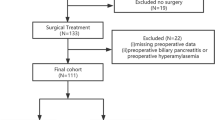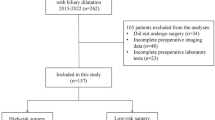Abstract
Purpose
To develop a model to identify risk factors and predict recurrent cases of intussusception in children.
Methods
Consecutive cases and recurrent cases of intussusception in children from January 2016 to April 2022 were screened. The cohort was divided randomly at a 4:1 ratio to a training dataset and a validation dataset. Three parallel models were developed using extreme gradient boosting (XGBoost), logistic regression (LR), and support vector machine (SVM). Model performance was assessed by the area under the receiver operating characteristic curves (AUC).
Results
A total of 2469 cases of intussusception were included, where 225 were recurrent cases. The XGBoost (AUC = 0.718) models showed the best performance in the validation dataset, followed by the LR model (AUC = 0.652), while the SVM model (AUC = 0.613) performed worst among the three models. Based on the Shapley Additive exPlanation values, the most important variables in the XGBoost models were air enema pressure, mass size, age, duration of symptoms, and absence of vomiting.
Conclusions
Machine learning models, especially XGBoost, could be used to predict recurrent cases of intussusception in children. The most important contributing factors to the models are air enema pressure, mass size, age, duration of symptoms and absence of vomiting.







Similar content being viewed by others
References
Niramis R, Watanatittan S, Kruatrachue A et al (2010) Management of recurrent intussusception: nonoperative or operative reduction? J Pediatr Surg 45(11):2175–2180
Cho MJ, Nam CW, Choi SH et al (2020) Management of recurrent ileocolic intussusception. J Pediatr Surg 55(10):2150–2153
Chen X, Chen Q, Wang X et al (2021) Clinical characteristics of recurrent intussusception: a single-center retrospective study. J Pediatr Surg 56(10):1831–1834
Guo WL, Wang J, Zhou M et al (2011) The role of plain radiography in assessing intussusception with vascular compromise in children. Arch Med Sci 7(5):877–881
Guo WL, Hu ZC, Tan YL et al (2017) Risk factors for recurrent intussusception in children: a retrospective cohort study. BMJ Open 7(11):e018604
Xie X, Wu Y, Wang Q et al (2018) Risk factors for recurrence of intussusception in pediatric patients: a retrospective study. J Pediatr Surg 53(11):2307–2311
Kourou K, Exarchos TP, Exarchos KP et al (2014) Machine learning applications in cancer prognosis and prediction. Comput Struct Biotechnol J13:8–17
Han X, Geng J, Zhang XX et al (2022) Using machine learning models to predict acute pancreatitis in children with pancreaticobiliary maljunction. Surg Today. https://doi.org/10.1007/s00595-022-02571-y
Ting X, Xufei D, Jiangbin L et al (2022) Development and validation of a nomogram for predicting pathological intussusceptions in children prior to surgical intervention. Front Pediatr 10:877358
Tseng PY, Chen YT, Wang CH et al (2020) Prediction of the development of acute kidney injury following cardiac surgery by machine learning. Crit Care 24(1):478
Goto T, Camargo CA Jr, Faridi MK et al (2018) Machine learning approaches for predicting disposition of asthma and COPD exacerbations in the ED. Am J Emerg Med 36:1650–1654
Goto T, Camargo CA Jr, Faridi MK et al (2019) Machine learning-based prediction of clinical outcomes for children during emergency department triage. JAMA Netw Open 2(1):e186937
Yuan KC, Tsai LW, Lee KH et al (2020) The development an artificial intelligence algorithm for early sepsis diagnosis in the intensive care unit. Int J Med Inform 141:104176
Xu L, Yang P, Liang W et al (2019) A radiomics approach based on support vector machine using MR images for preoperative lymph node status evaluation in intrahepatic cholangiocarcinoma. Theranostics 9(18):5374–5385
Zhang Y, Shao CC, Wei XL et al (2022) Ultrasound findings to predict risk of recurrence in pediatric intussusception after air enema reduction. J Ultrasound Med 41(5):1227–1235
Kim JH, Lee JS, Ryu JM et al (2018) Risk factors for recurrent intussusception after fluoroscopy–guided air enema. Pediatr Emerg Care 34(7):484–487
Shen G, Zhang C, Li J, Zhang J et al (2018) Risk factors for short-term recurrent intussusception and reduction failure after ultrasound-guided saline enema. Pediatr Surg Int 34(11):1225–1231
Wang Z, He QM, Zhang H et al (2015) Intussusception patients older than 1 year tend to have early re-currence after pneumatic enema reduction. Pediatr Surg Int 31(9):855–858
Justice FA, Nguyen LT, Tran SN et al (2011) Recurrent intussusception in infants. J Paediatr Child Health 47:802–805
Champoux AN, Del Beccaro MA, Nazar-Stewart V (1994) Recurrent intussusception. Risks and features. Arch Pediatr Adolesc Med 148:474–478
Lin XK, Xia QZ, Huang XZ et al (2017) Clinical characteristics of intussusception secondary to pathologic lead points in children: a single-center experience with 65 cases. Pediatr Surg Int 33(7):793–797
Author information
Authors and Affiliations
Contributions
Contributors Y-FQ designed the study; J-YG and Y-FQ collected data; J-YG analysed the data; J-YG and Y-FQ wrote and revised the manuscript; and all authors read and approved the final version of manuscript.
Corresponding author
Ethics declarations
Conflict of interest
We have no conflicts of interest to declare.
Ethical approval
The authors are accountable for all aspects of the work in ensuring that questions related to the accuracy or integrity of any part of the work are appropriately investigated and resolved. The study was conducted in accordance with the Declaration of Helsinki (as revised in 2013). The study protocol was approved by the Ethics Committee of the Children’s Hospital of Soochow University.
Additional information
Publisher's Note
Springer Nature remains neutral with regard to jurisdictional claims in published maps and institutional affiliations.
Rights and permissions
Springer Nature or its licensor (e.g. a society or other partner) holds exclusive rights to this article under a publishing agreement with the author(s) or other rightsholder(s); author self-archiving of the accepted manuscript version of this article is solely governed by the terms of such publishing agreement and applicable law.
About this article
Cite this article
Guo, Jy., Qian, Yf. Predicting recurrent cases of intussusception in children after air enema reduction with machine learning models. Pediatr Surg Int 39, 9 (2023). https://doi.org/10.1007/s00383-022-05309-6
Accepted:
Published:
DOI: https://doi.org/10.1007/s00383-022-05309-6




